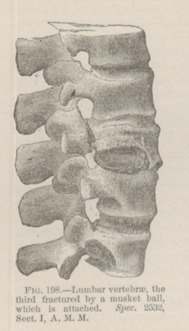Title: D——, Thomas
Source text: Surgeon General Joseph K. Barnes, United States Army, The Medical and Surgical History of the War of the Rebellion. (1861–65.), Part 1, Volume 2 (Washington, D.C.: Government Printing Office, 1870), 445-446.
Civil War Washington ID: med.d1e18906
TEI/XML: med.d1e18906.xml
CASE.—Private Thomas D——, Co. F, 1st Michigan Sharp-shooters, aged 19 years, received a gunshot wound of the lumbar region, at Petersburg, June 24th, 1864. He was admitted, on the same day, to the field hospital of the 3d division, Ninth Corps, and, on July 1st, sent to Stanton Hospital, Washington. Stimulants were freely administered, with subcutaneous injections of sulphate of morphia. Tetanus, in the form of opisthotonos and trismus, appeared on the 4th. Death resulted on July 5th, 1864. At the necropsy, a conoidal ball was found to have entered on the left side, over the posterior part of the crest of the ilium, passed upward and inward, and lodged in the left side of the body of the third lumbar vertebra. The anterior crural nerve was injured, as was also the lower end of the left kidney. There was limited peritonitis, and a small collection of pus, say a drachm, about where the ball impinged against the peritoneum, at lower end of kidney. The intestines were not injured. The pathological specimen is No. 2762, Section I, A. M. M., and was contributed, with a history of the case, by Assistant Surgeon George A. Mursick, U. S. V.
The adjoining cut represents the lumbar vertebræ, with the third fractured by a conoidal ball, which is attached. The missile appears to have passed from the left directly through the intervertebral notch between the third and fourth vertebræ, chipping the superior articular process of the fifth and the adjacent portion of the spinous process of the fourth, fracturing the left transverse process of the fourth, and emerging through the body of that vertebra on the right side. Life continued long enough for incipient caries to present itself. The specimen was contributed to the Army Medical Museum by Surgeon John A. Lidell, U. S. V., without an history. A comparison of the specimen with the registers and case-books of Carver Hospital, and with Dr. Lidell's excellent paper On Injuries of the Spine (Amer. Jour. of Med. Sci., October, 1864, Vol. XLVIII), does not permit a reference of this specimen to any of the histories recorded there. It corresponds closely to several of the recorded cases, and more than one history has been attached to it; but some vital discrepancy between the history and specimen has been subsequently detected. The history of the case that compares most closely with the specimen represents the patient as alive a fortnight after the preparation was on the shelves of the Museum; and, in other abstracts, where dates agree, there is discordance as to position and extent of lesions. The specimen was received from Stanton Hospital, June 18th, 1864.
